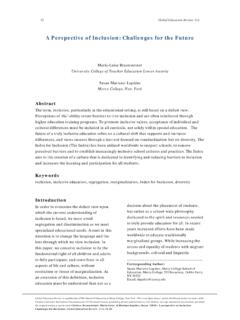Transcription of Central bank digital currencies - Bank for International ...
1 European Central BankBank of JapanSveriges RiksbankSwiss National BankBank of EnglandBoard of Governors Federal Reserve SystemBank for International SettlementsBank of CanadaCentral bank digital currencies : foundational principles and core featuresin a series of collaborations from a group of Central banks Report no 1 This publication is available on the BIS website ( ). Bank for International Settlements 2020. All rights reserved. Brief excerpts may be reproduced or translated provided the source is stated. ISBN: 978-92-9259-427-5 (online) Central bank digital currencies : foundational principles and core features i Contents Executive summary .. 1 1. Introduction .. 2 The report .. 3 CBDC explained.
2 3 Synthetic CBDC is not a CBDC .. 4 2. Motivations, challenges and risks .. 5 Payment motivations and challenges .. 5 Cross-border payments and CBDC .. 7 Monetary policy motivations and risks .. 8 Financial stability 8 Balancing motivations and risks .. 9 3 Issuing a CBDC .. 10 Three foundational principles .. 10 Core features .. 11 4 CBDC design and technology .. 12 Design choices .. 12 Technology considerations .. 13 Key trade-offs .. 15 5. Concluding thoughts and next steps .. 16 References .. 18 Annex A: Questions to guide further research .. 19 Annex B: Group members .. 20 Central bank digital currencies : foundational principles and core features 1 Executive summary Central banks have been providing trusted money to the public for hundreds of years as part of their public policy objectives.
3 Trusted money is a public good. It offers a common unit of account, store of value and medium of exchange for the sale of goods and services and settlement of financial transactions. Providing cash for public use is an important tool for Central banks. Yet the world is changing. Even before Covid-19, cash use in payments was declining in some advanced economies. Commercially provided, fast and convenient digital payments have grown enormously in volume and diversity. To evolve and pursue their public policy objectives in a digital world, Central banks are actively researching the pros and cons of offering a digital currency to the public (a general purpose Central bank digital currency (CBDC)).
4 Understanding of CBDCs has advanced significantly in the last few years. Published research, policy work and proofs-of-concept from Central banks have gone a long way towards establishing the potential benefits and risks. For the Central banks contributing to this report, the common motivation for exploring a general purpose CBDC is its use as a means of payment. Providing cash to the public is a core responsibility of Central banks and a public good. All the contributing Central banks commit to continue providing cash as long as there is public demand. Yet a CBDC could provide a complementary Central bank money to the public, supporting a more resilient and diverse domestic payment system. It might also offer opportunities not possible with cash while supporting innovation.
5 CBDC issuance and design are sovereign decisions to be made by each jurisdiction. This report is not about if or when to issue a CBDC. Central banks will make that decision for their jurisdictions (in consultation with governments and stakeholders). None of the Central banks contributing to this report have reached a decision on whether or not to issue a CBDC. Instead, this report advances the foundational International work by outlining common principles and the key features a CBDC and supporting infrastructure would need in order to contribute to Central bank public policy objectives. The principles emphasise that: (i) a Central bank should not compromise monetary or financial stability by issuing a CBDC; (ii) a CBDC would need to coexist with and complement existing forms of money; and (iii) a CBDC should promote innovation and efficiency.
6 The possible adverse impact of a CBDC on bank funding and financial intermediation, including the potential for destabilising runs into Central bank money, has been a concern of Central banks. Any decision to launch a CBDC would depend on an informed judgment that these risks can be managed, likely through some combination of safeguards incorporated in the design of a CBDC and financial system policies more generally. Understanding the potential market structure effects of CBDC, their implications for financial stability, and any potential mitigants is a further area of work for this group. A CBDC robustly meeting these criteria and delivering the features set out by this group could be an important instrument for Central banks to deliver their public policy objectives.
7 This potential, together with the agreement on common principles and features, means there is considerable scope for future International collaboration, knowledge-sharing and experimentation on CBDC. Simultaneous research and development of CBDC by Central banks could also explore ways to improve cross-border payments, as part of the G20 roadmap (CPMI (2020)), while avoiding spillovers and unintended consequences. The next stage of CBDC research and development will emphasise individual and collective practical policy analysis and applied technical experimentation by Central banks. This report highlights CBDC design and technology considerations, including initial thoughts on where trade-offs lie. Far more work is required to truly understand the many issues, including where and how a Central bank should play 2 Central bank digital currencies : foundational principles and core features a direct role in an ecosystem and what the appropriate role might be for private participation.
8 The speed of innovation in payments and money means that these questions are ever more urgent. A CBDC could be an important instrument for Central banks to continue to provide a safe means of payment in step with wider digitalisation of people s day-to -day lives. Public trust in Central banks is Central to monetary and financial stability and the provision of the public good of a common unit of account and secure store of value. To maintain that trust and understand if a CBDC has value to a jurisdiction, a Central bank should proceed cautiously, openly and collaboratively. This group of Central banks will continue to work actively and collaboratively on CBDC, further exploring the practical implications of the core features.
9 Individually, the contributing Central banks will continue outreach efforts in order to foster an open and informed dialogue with domestic stakeholders on CBDC. Collaboratively, we will also explore practical issues and challenges for broad interoperability of domestic CBDCs in accord with related International workstreams (eg the G20 roadmap on cross-border payments) We welcome further BIS information sharing on CBDC and BIS Innovation Hub plans to explore the technologies that could support CBDCs. 1. Introduction Central banks have a mandate for monetary and financial stability in their jurisdictions and, explicitly or implicitly, to promote broad access to safe and efficient payments. A core instrument by which Central banks carry out their public policy objectives is providing the safest form of money to banks, businesses and the public Central bank money.
10 This money acts as a means of payment, unit of account and store of value for a jurisdiction. A common unit of account is a public good that allows goods and services to be exchanged and financial transactions to be settled efficiently and safely. Today, Central banks provide money to the public through cash and to banks and other financial companies through reserve and settlement accounts. In this way, some of the smallest and largest payments in an economy are carried out using Central bank money. Yet the ongoing digitalisation of the economy is changing the way people pay. The use of cash, currently the only form of Central bank money available to the public, is falling in many jurisdictions. The Covid-19 pandemic may be accelerating this trend.


















